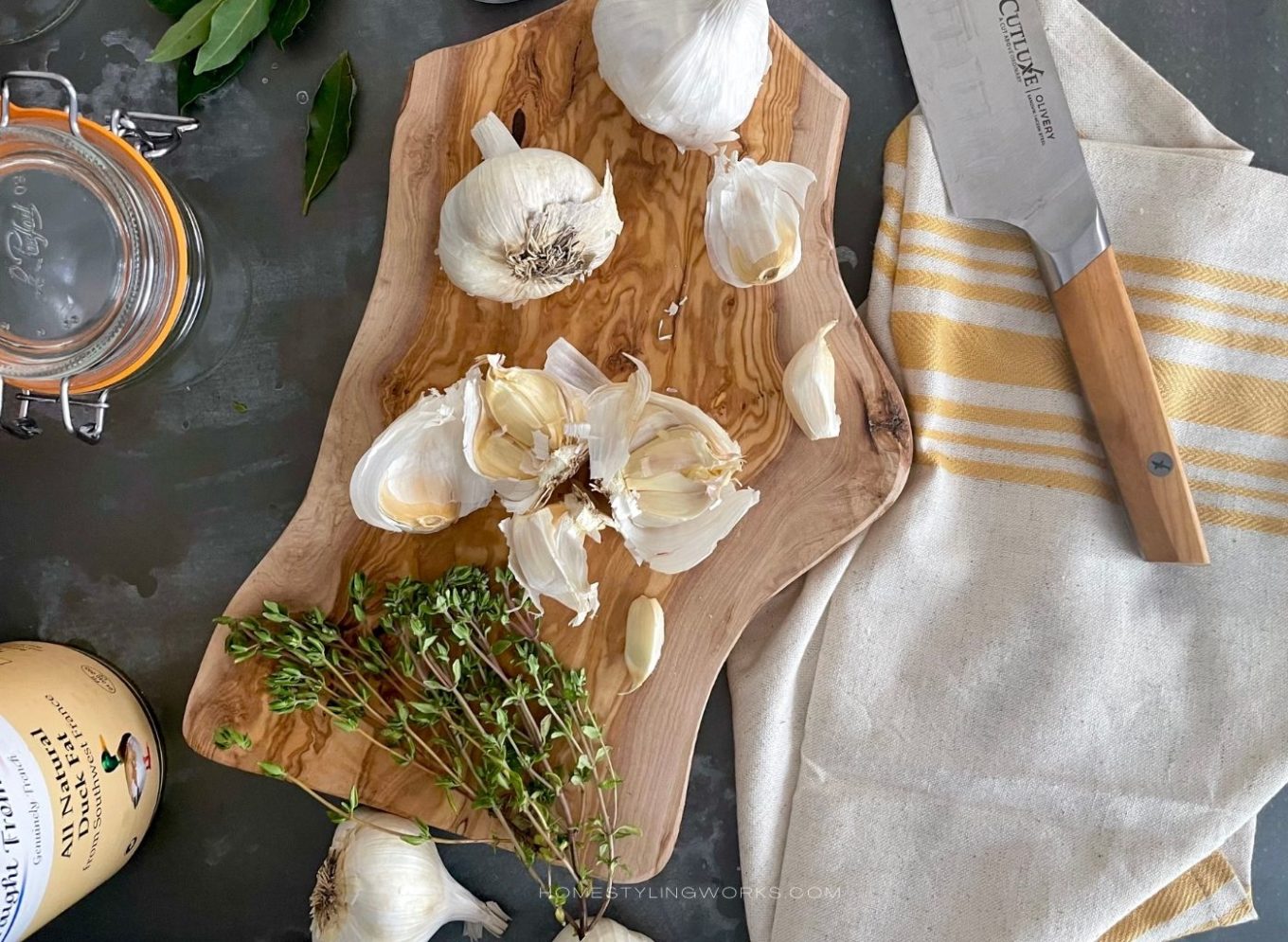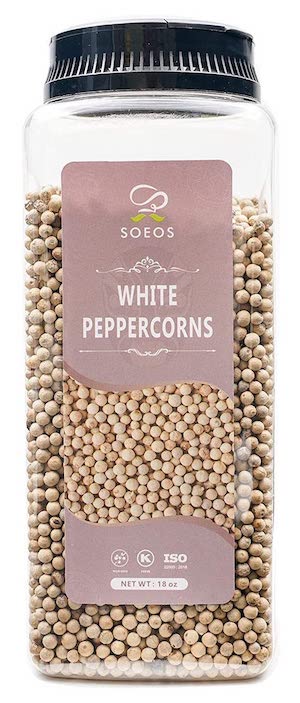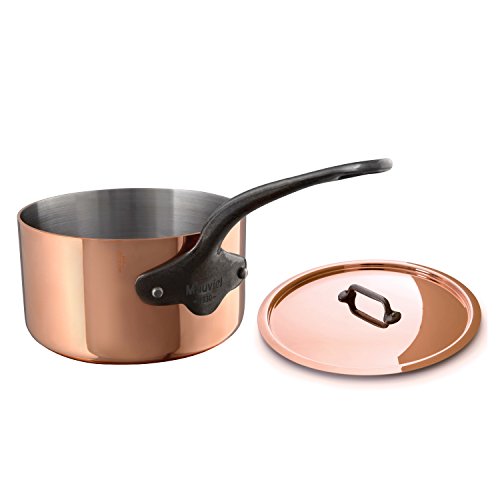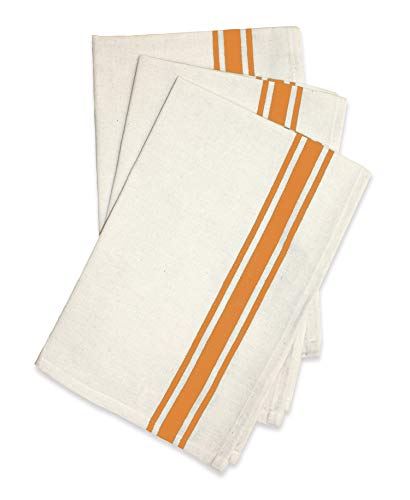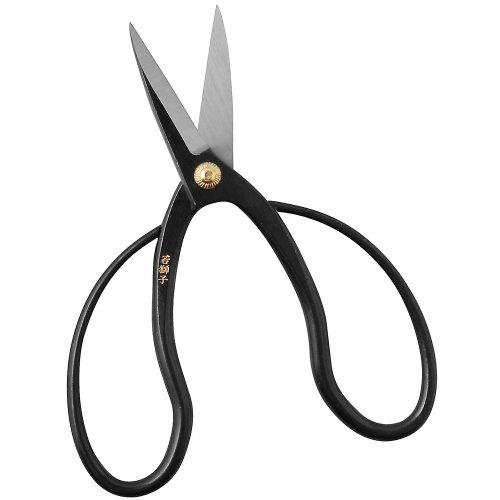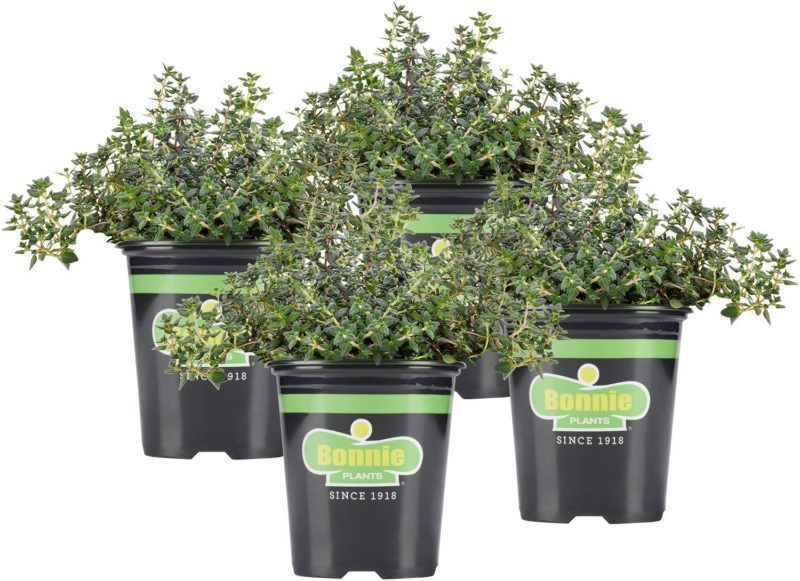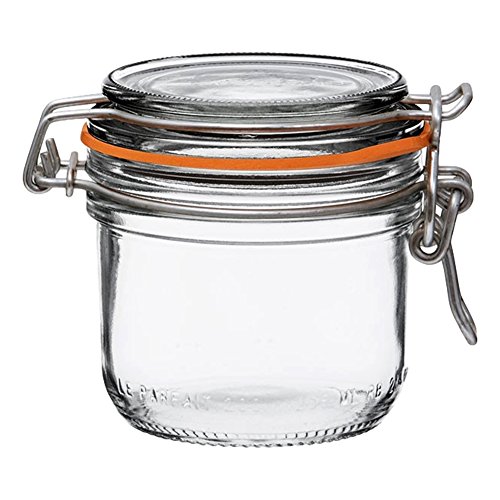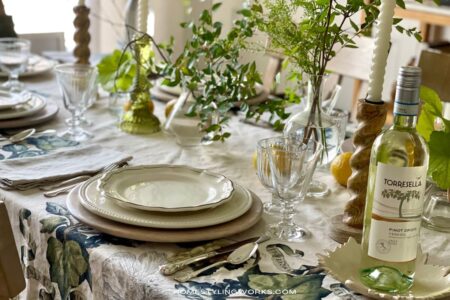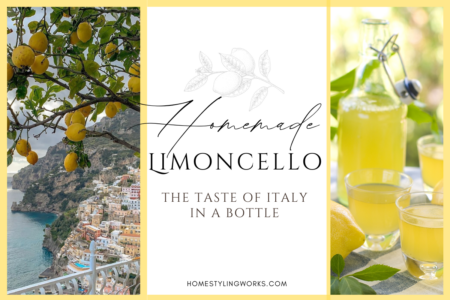INTRODUCING GARLIC CONFIT
One of the things I love the most about cooking is the alchemy that happens when you transform a simple ingredient (like farmer’s market garlic) into something sublime and ethereal. Garlic confit is all about that transformation – turning a bitter and pungent ingredient that you would never eat raw (unless you were alone on a deserted island) into a buttery, silken, rich and flavorful ingredient. And not at all bitter and pungent.
Garlic Confit is the easiest thing to make! It’s takes only six ingredients and under an hour – and you can use it as a base in in stews and soups (more on how to use Garlic Confit later in the post). This is like roasted garlic, only better!
WHAT IS CONFIT?
Confit (pronounced kone-FEE) is a French word that means “to preserve”.
Confit as a cooking term describes when food is cooked in oil at a lower temperature over a long period of time. It’s the opposite of deep frying, which takes place at temperatures of 160–230 °C. Confit preparations are done at a much lower temperature, around 90 °C, or sometimes even cooler. The term is usually used in modern cuisine to mean long slow cooking in oil or fat at low temperatures.
The most well-known application for confit cooking is Duck Confit, which is used in the classic French dish Cassoulet (I’ve made that and it’s a two-day endeavor – which makes my Bolognese Ragu recipe look easy by comparison!). One of the best recipes for Duck Confit and Cassoulet is in one of my Favorite Cookbooks – “The Country Cooking of France” by cooking school owner Anne Willan. You can also check out more of my favorite cookbooks in my Kitchen Arts shop.
A couple of things to know before we start.
GARLIC VARIETIES
If you have a good local farmer’s market, I suggest procuring your garlic from a purveyor there. Below are a couple of different varieties of garlic. The garlic on the left is soft neck garlic I spotted at the open air market in Munich, and the garlic on the right is spring garlic from the farmer’s market in Palo Alto, CA. The variety of garlic isn’t as important as the freshness. Before buying, give it a light squeeze – it should feel tight, and there shouldn’t be bruising or brown spots on the outside.

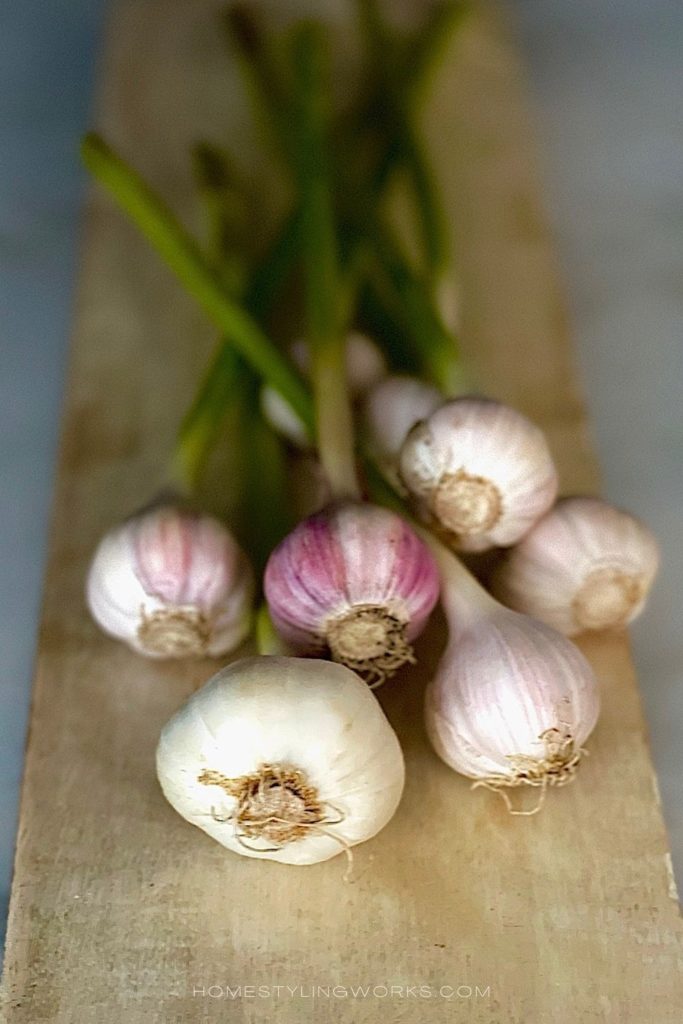
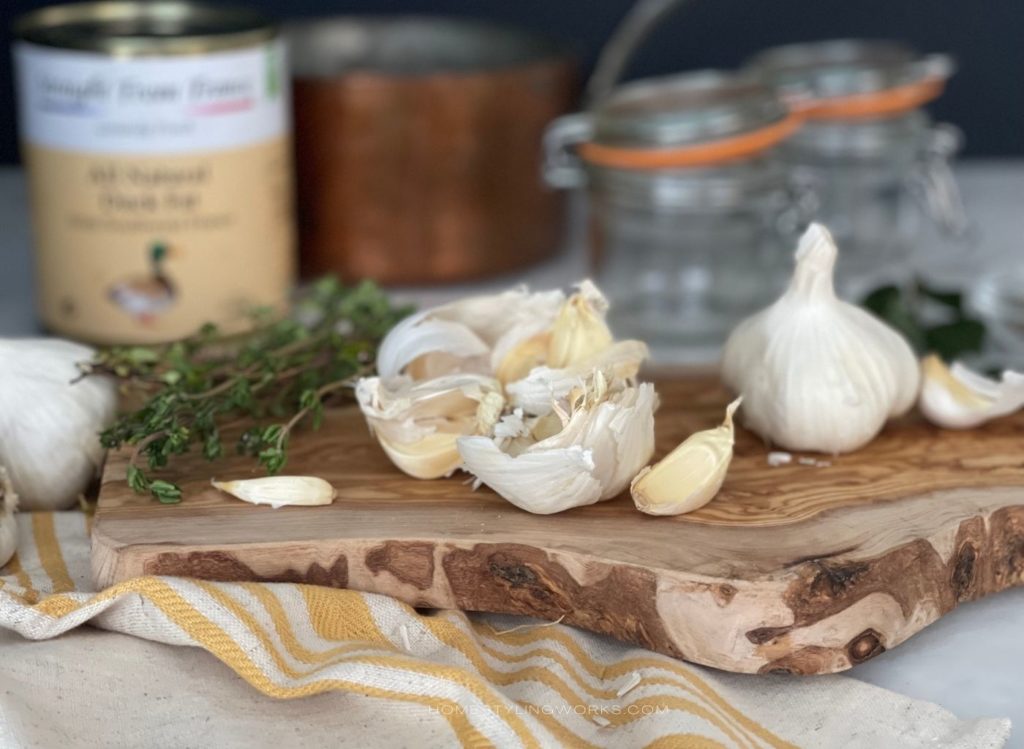
DUCK FAT = FLAVOR
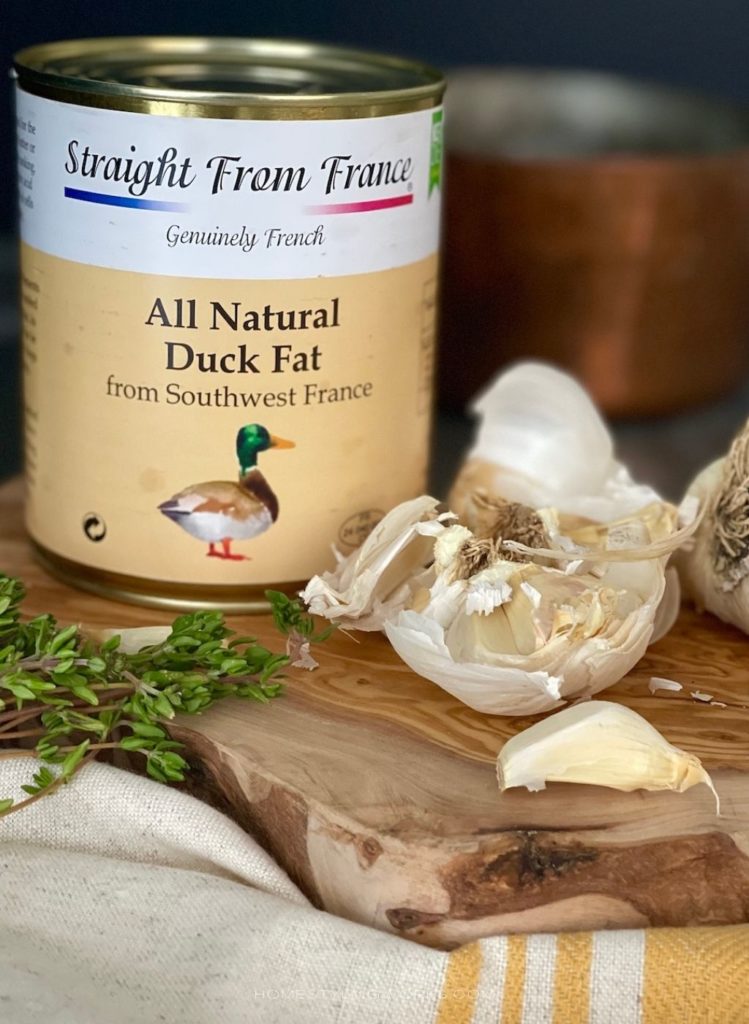
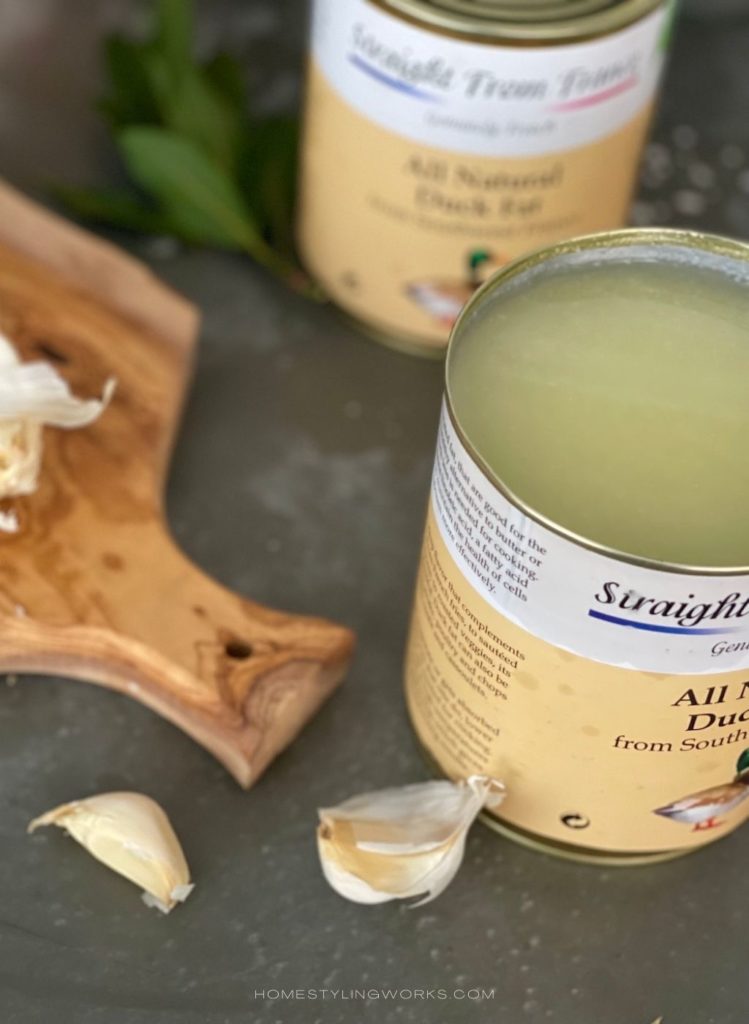
Confit involves slowly poaching the garlic cloves in oil (or fat), and my fat of choice is Duck Fat. Don’t be put off by the name – it’s rich in monounsaturated fat that’s good for the heart. It’s also Keto, Paleo and Whole30 diet friendly. Duck fat has a neutral flavor and foods cooked with duck fat taste like a better version of themselves.
The duck fat I used is from a brand I love called Straight From France, and it’s preservative and gluten free. And hey – it’s Straight From France! But you can always substitute good old extra virgin olive oil. I’ve made the confit both ways, and, in my opinion, the duck fat adds a richer flavor. But both are still really delicious!
LE PARFAIT JARS
Let me introduce you to my little friends.
The jars you use matter when you’re working with preserving food.
The inexpensive flip-top glass jars are fine if you’re storing thumbtacks and other office supplies – in other words, non-perishables. But for preserving food, the good stuff is made in France. Le Parfait was founded in the early 1930s in Reims, France, at Verreries Mécaniques Champenoises (VMC), a major glass-making company, and the tradition continues to this day.

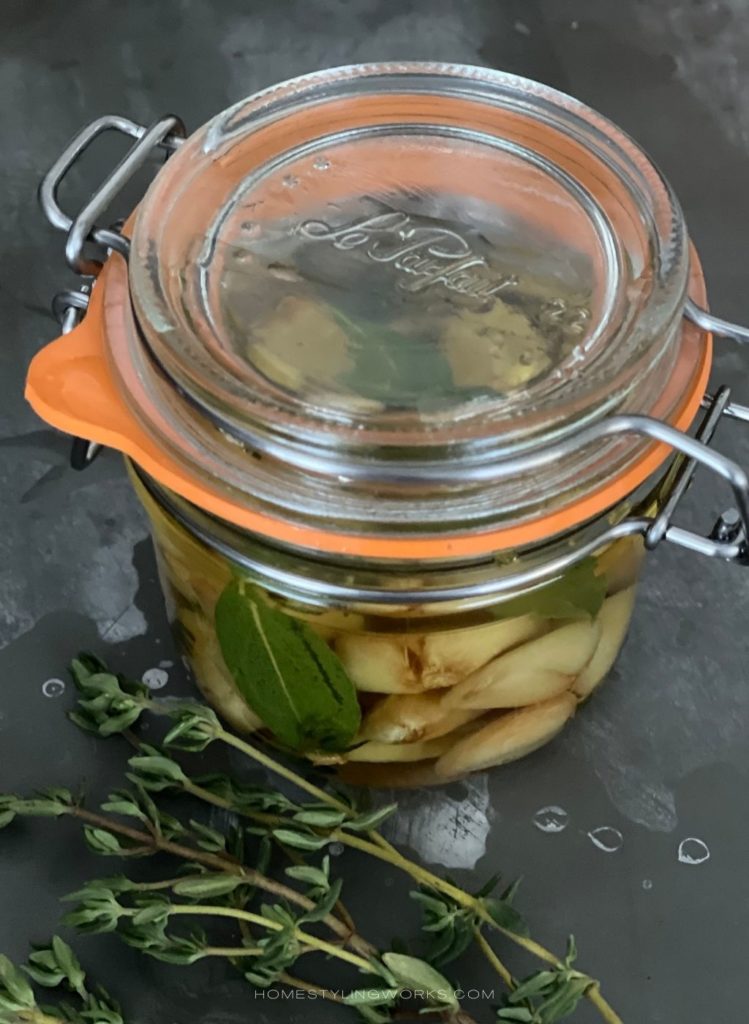
Le Parfait jars (or terrines) come in a wide variety of sizes, and are BPA free and dishwasher safe (including the gasket). Although they’re a little more expensive (the half-pint jars I used in this post cost about $6 each), they’re worth it because the seal on the jars is airtight. Also, there’s a chance that the cheap stuff will shatter – not a good idea when working with food. Plus they’re good looking!
(You can read more about my favorite French brands in this post).
THE RIGHT SAUCE PAN
The pan you use is important – you want a heavy saucepan that retains heat. I made the confit in one of my favorite copper saucepans that I’ve been collecting for years – the 5.5 quart Mauviel saucepan. Below right, my former kitchen was featured in Renovation Style magazine a few years ago and my copper pans played a starring role!
I’ve linked to my favorite investment copper pots and pans in my Online Shop here.

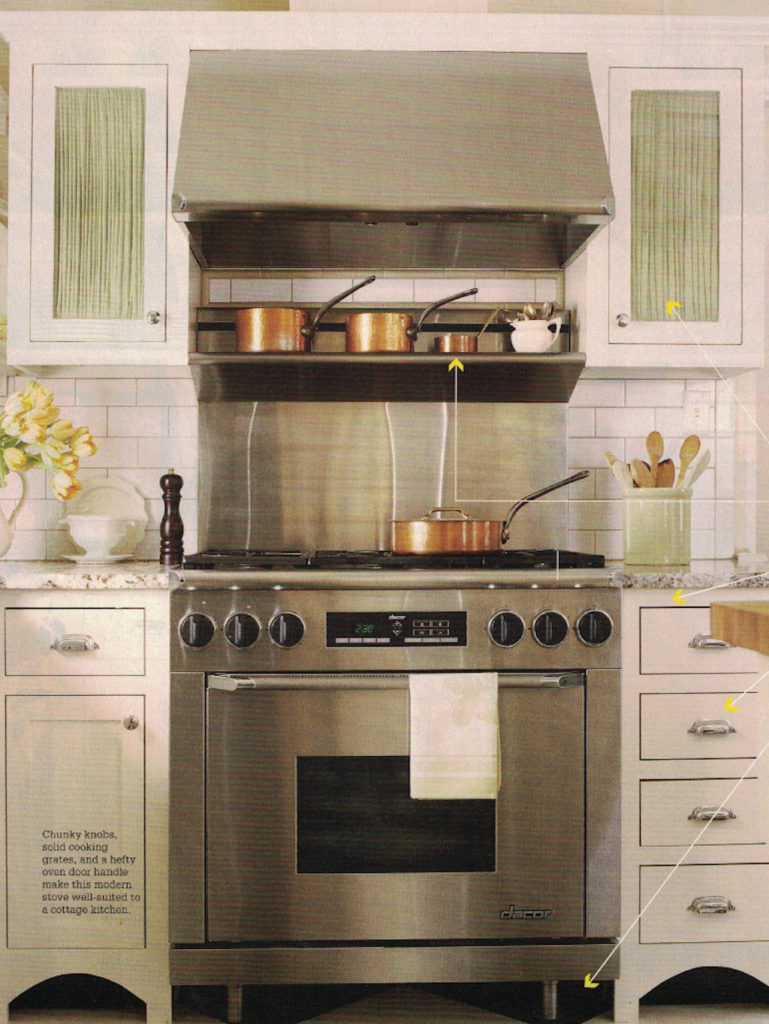
HOW TO MAKE GARLIC CONFIT

Garlic Confit
Ingredients
- 3 heads garlic
- 1 24 ounce can duck fat (or 3 cups extra virgin olive oil)
- 8 sprigs fresh thyme Reserve 2 sprigs
- 15 whole white peppercorns (or 15 whole black peppercorns)
- 1-1/2 tsp. kosher salt
- 6 fresh bay leaves Reserve 2 leaves
Instructions
- Remove the outer paper from the heads of garlic.
- With the flat side of a chef's knife, lightly smash the head of garlic to separate the cloves.
- Remove the outer wrapper from all the garlic cloves and place in a medium-sized saucepan. Make sure the garlic cloves are whole, so they all cook evenly.
- Add duck fat, 6 sprigs of thyme, 4 bay leaves, peppercorns and salt to the garlic in the saucepan.
- Over the very lowest heat, slowly render the duck fat into the garlic cloves and lightly poach for 40 minutes, until the garlic is very soft (but not falling apart). Use a simmer plate, if necessary, to keep the heat evenly low.
- Remove pan from heat and carefully remove the thyme sprigs and bay leaves and discard. Transfer the garlic with a slotted spoon into 2 clean half-pint jars, evenly distributing the garlic between the jars.
- Let the oil cool in the pan off heat for 15 minutes. Add oil to the jars to cover all the garlic. Keep the jar lid open and cool the mix to room temperature before refrigerating.
- When cool, cover tightly and keep refrigerated (or freeze for later use).
- TIP: Use a clean spoon or knife when dipping into the jar.
- ALWAYS KEEP REFRIGERATED BETWEEN USES
FRESH HERBS
You know the kitchen saying that goes “the fewer the ingredients, the better they need to be”? That applies here. Using fresh herbs in your confit is very important, as they impart a lot of flavor punch. Also, dried herbs take on a much deeper (and sometime, altogether different, flavor), so I recommend using fresh herbs in this recipe.
THYME (ENGLISH OR FRENCH)
I have fresh thyme growing in a container in my garden (below left), but you can easily find it at the supermarket with the packaged fresh herbs.

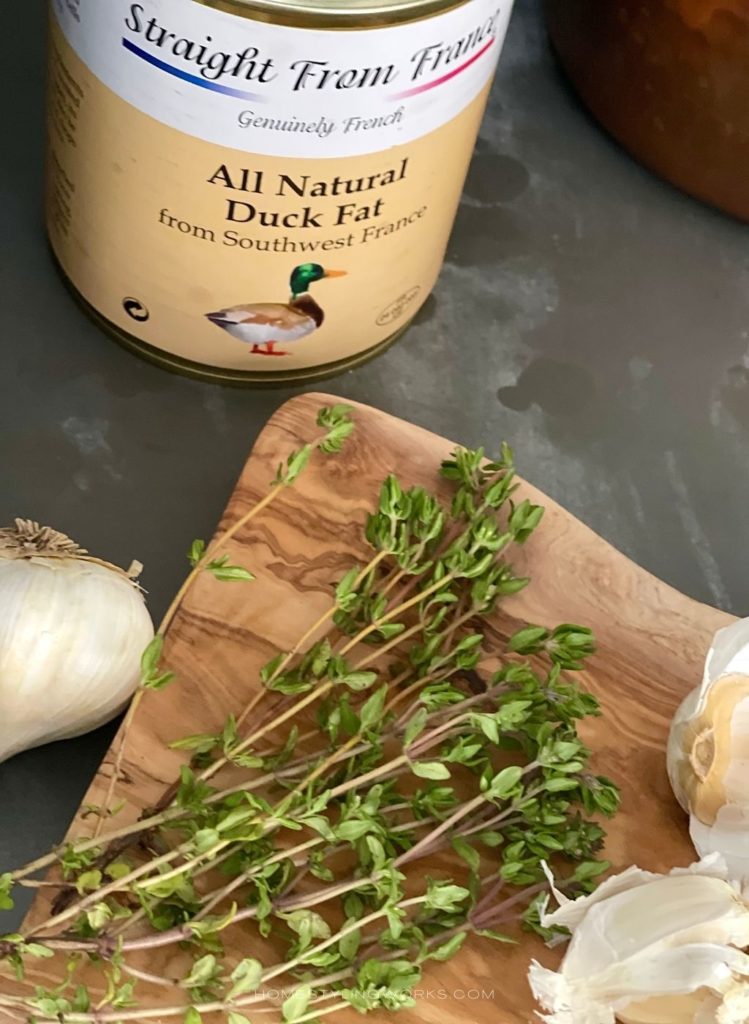
FRESH BAY LEAVES
I also recommend using fresh bay leaves, which are easy to find at Whole Foods or your local supermarket. And if you live in a mild gardening climate, you can grow a bay laurel tree or shrub in a planter. I’ve been nurturing my bay tree since it was a foot high and 6 years later, it’s 7 feet tall and takes center stage in my kitchen garden. You can buy a small bay laurel tree here.
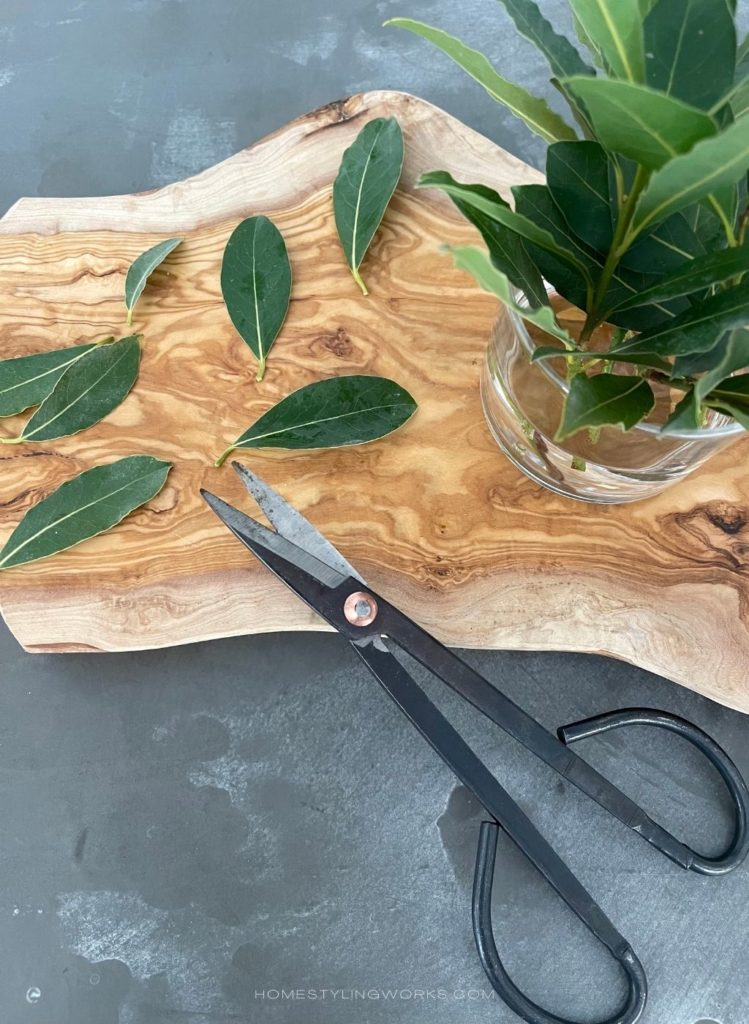
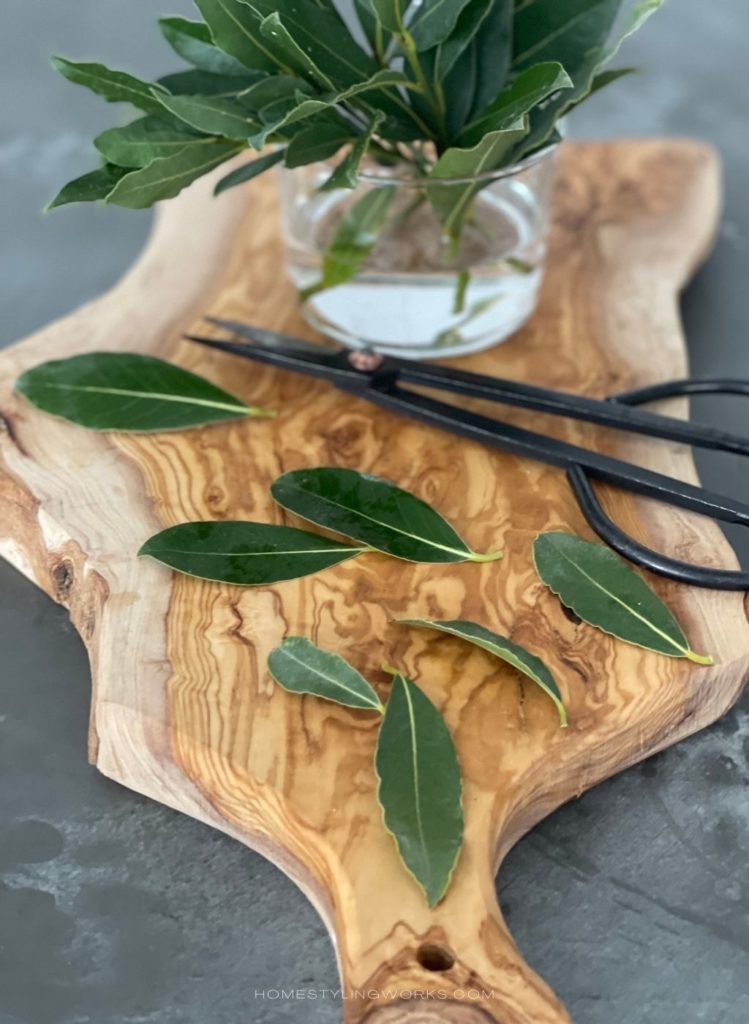
PEELING THE GARLIC
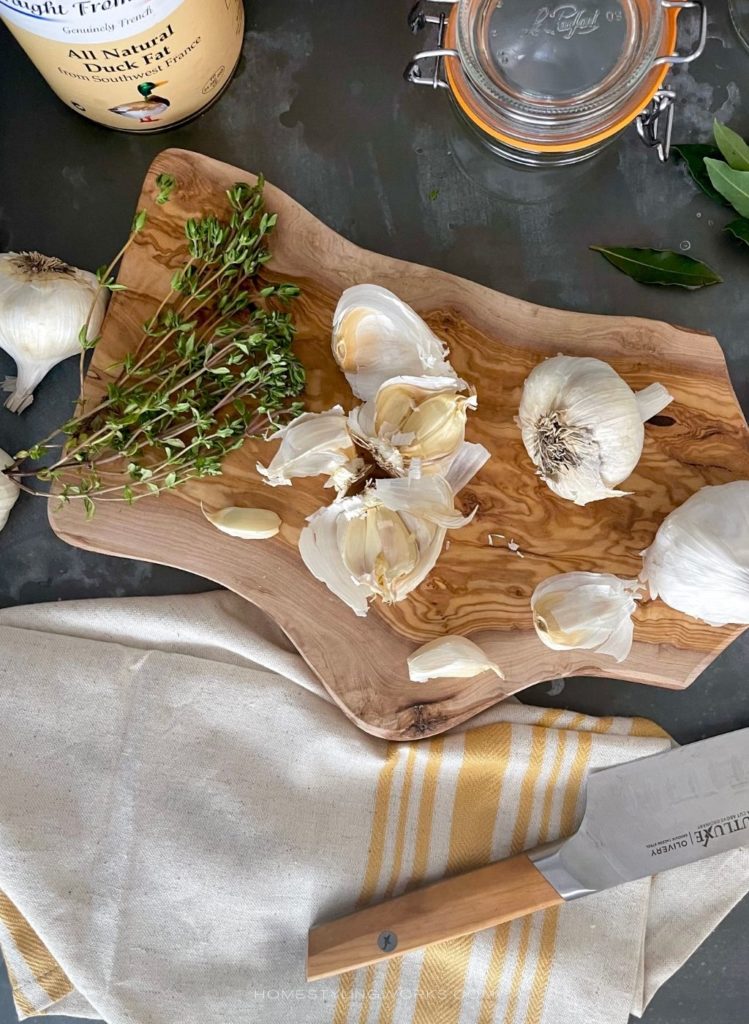
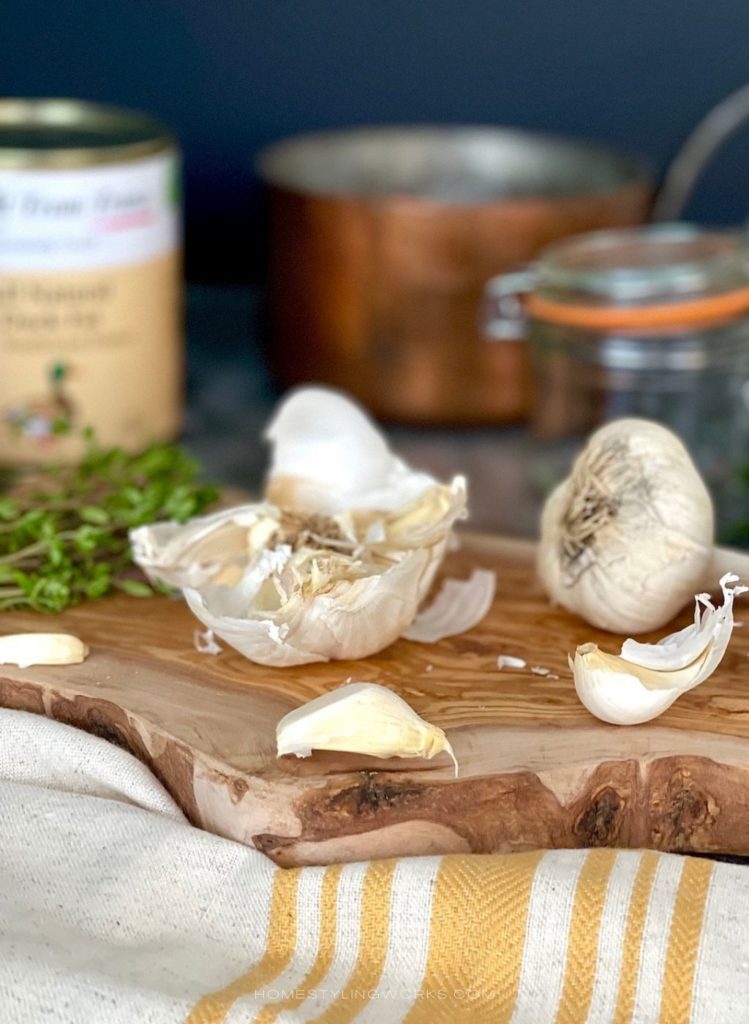
This recipe calls for three whole heads of garlic, which you’ll separate into individual cloves which need to be peeled. An easy way to remove the outer wrapper from each garlic clove is to lightly tap each clove with the side of a chef’s knife, to loosen the skin. This is the most time-consuming part of the recipe, but it’s one of those relaxing, repetitive kitchen tasks I happen to enjoy. So grab a glass of wine and start peeling.
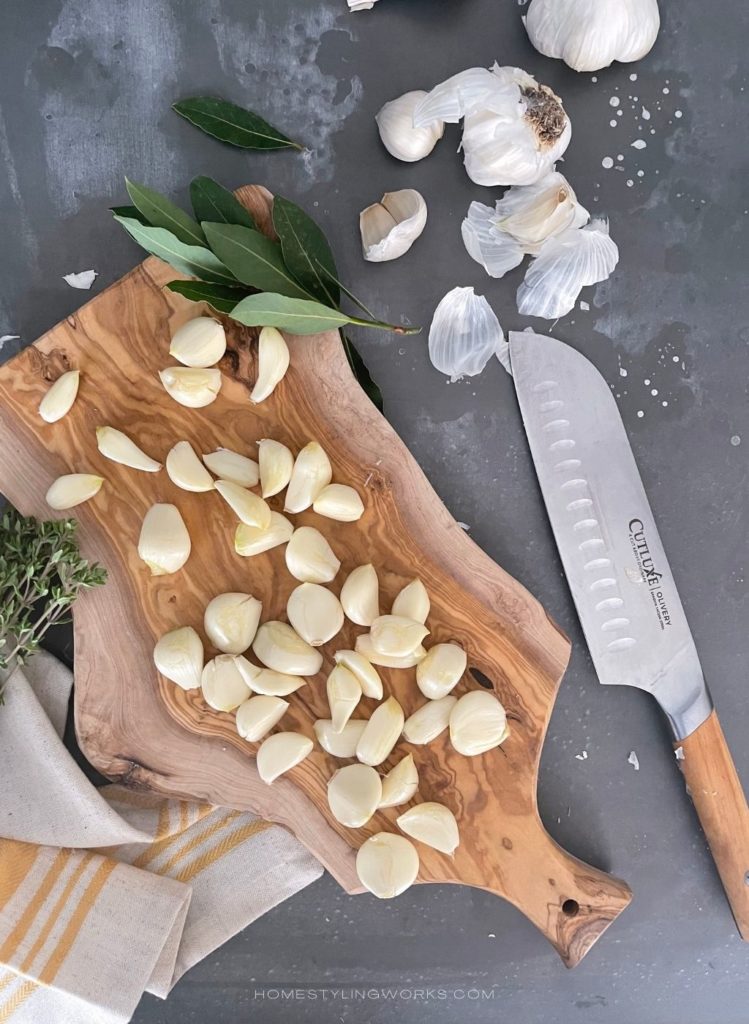

KITCHEN TIP: After peeling 30 cloves of garlic, your hands are going to announce what kitchen task you’ve been doing, so I have an easy way to remove the smell. Just put a teaspoon of salt and 2 teaspoons of baking soda in your hand. Add a small amount of water to make a paste and rub your hands together for 30 seconds. Afterwards, wash your hands with soap and water. The baking soda absorbs the odor and the salt acts as an exfoliant.
POACHING THE GARLIC
This is where everybody gets into the pool! Add the duck fat to the pan, turn the heat on very low, and add the garlic, thyme, bay leaves, salt and white peppercorns to the pan.
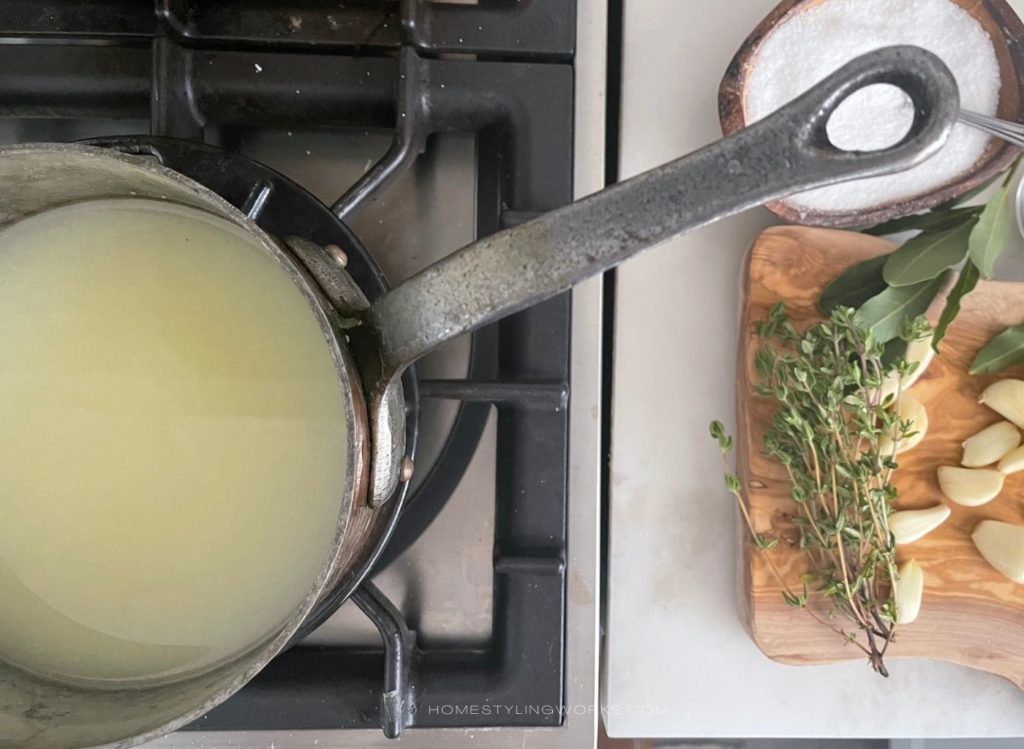


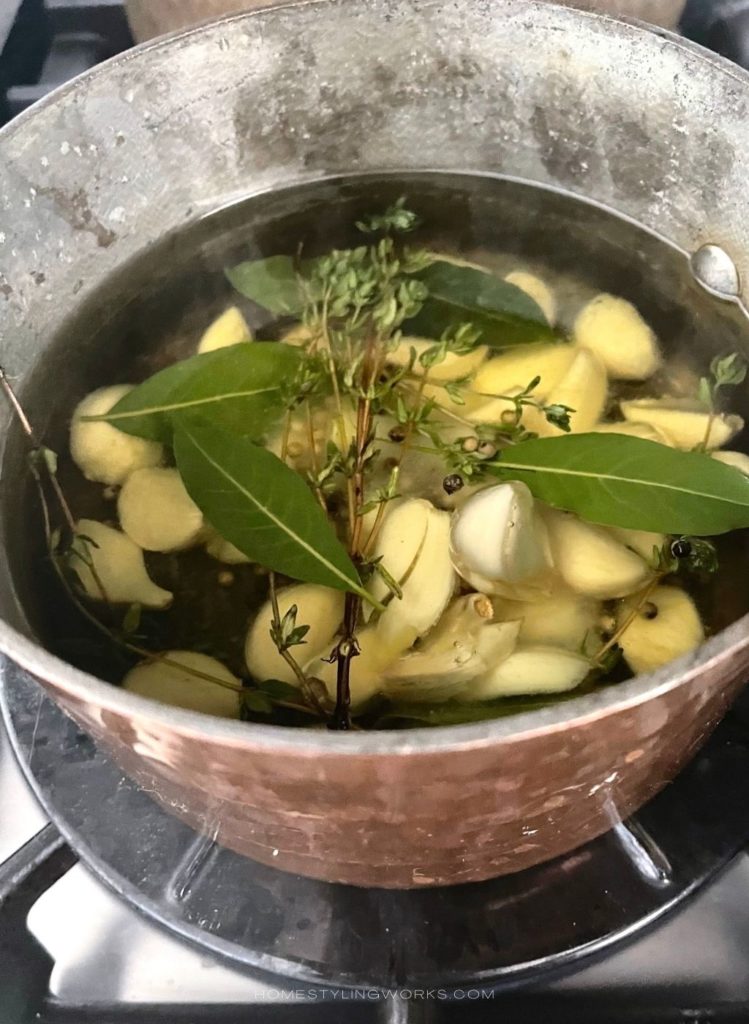
You’ll notice that the duck fat becomes more translucent when heated, so it looks like light olive oil. I used a simmer plate because my high-BTU European stove flame needs to be tamed. Set the timer for 40 minutes, enjoy the rest of your wine and take in the aromas that the garlic imparts as it slowly slowly s-l-o-w-l-y poaches in the duck fat.
After 40 minutes, take the pan off the heat and carefully remove the thyme stems and bay leaves. With a slotted spoon, take the garlic out of the oil and evenly distribute it between two half-pint Le Parfait jars. Let the oil cool off the heat for about 15 minutes. This is an important step – if you just take the pan off the heat and leave the garlic in there, it will continue to cook and possible turn brown. You want a rich, light golden hue to the garlic – not brown.
After 15 minutes, add the oil to the garlic in the jars, add a fresh bay leaf and thyme leaves (about 1/2 teaspoon) to each jar. Let cool for 30 minutes (below).
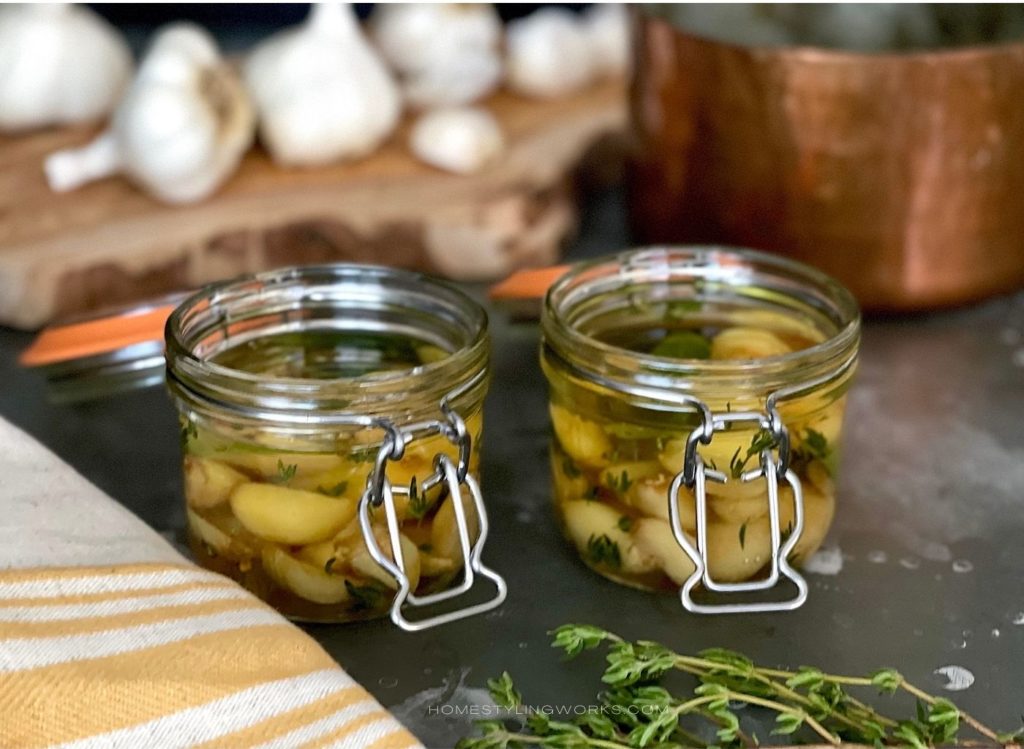
While the garlic and duck fat is cooling, you can take a whole clove and spread it on bread, as a substitute for butter. Delicious! But after it’s been refrigerated and the duck fat has solidified, that’s when it becomes a transformative ingredient to cook with.

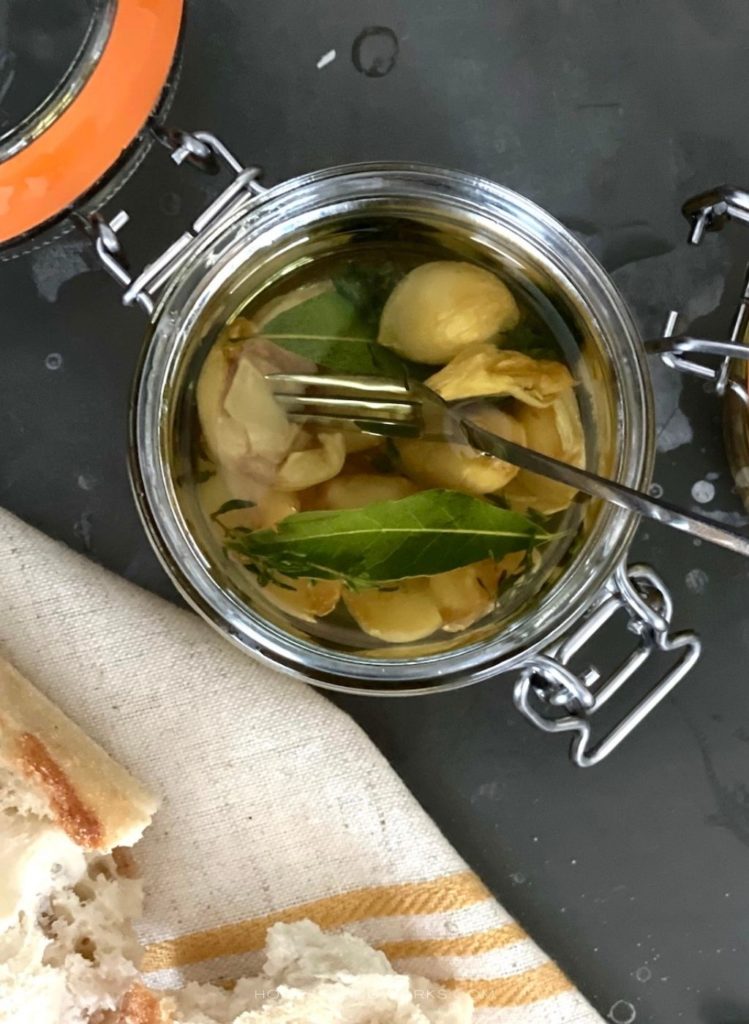
Once the confit is cooled, attach the lid and immediately refrigerate.


VERY IMPORTANT: STORAGE + FOOD SAFETY
It is VERY IMPORTANT that the confit is refrigerated. Do NOT leave this out on the counter or at room temperature. Use the garlic confit and put it back in the refrigerator. This is for food safety reasons (I’m looking at you, botulism). Make sure the confit jars are sanitized in the dishwasher before use. The reason I like the Le Parfait jars is their seal, which is imperative when storing food.
Also, if you’re giving this as a gift, include a little card with information on how to properly store the confit (remember: REFRIGERATE! Food safety first!)
HOW TO USE GARLIC CONFIT
The garlic pieces will solidify in the oil once refrigerated, so it won’t look like liquid (in the photos above) – it will look like a solid white mass. This is okay. It has the consistency of refrigerated butter, so you would use this like you would cooking any ingredient in olive oil, except you’re using garlic-and-herb-infused duck fat.
Here are a few ways to use garlic confit in your cooking:
- To saute vegetables
- As a base for a soup or stew
- Puréed in the food processor and added to a potato gratin
- Spread on the outside of a whole chicken before oven roasting
HOW LONG WILL IT LAST?
Stored in the refrigerator, it should keep for 3-5 months (it never lasts that long around here!) You can also freeze the garlic confit for several months (to prevent freezer burn, I put the jar inside of a plastic freezer bag).
SHOPPING GALLERY
CLICK THE IMAGES BELOW FOR PRODUCT LINKS
I hope this post has inspired you to Make Your Every Day More Beautiful® by adding special ingredients to your cooking repertoire!

